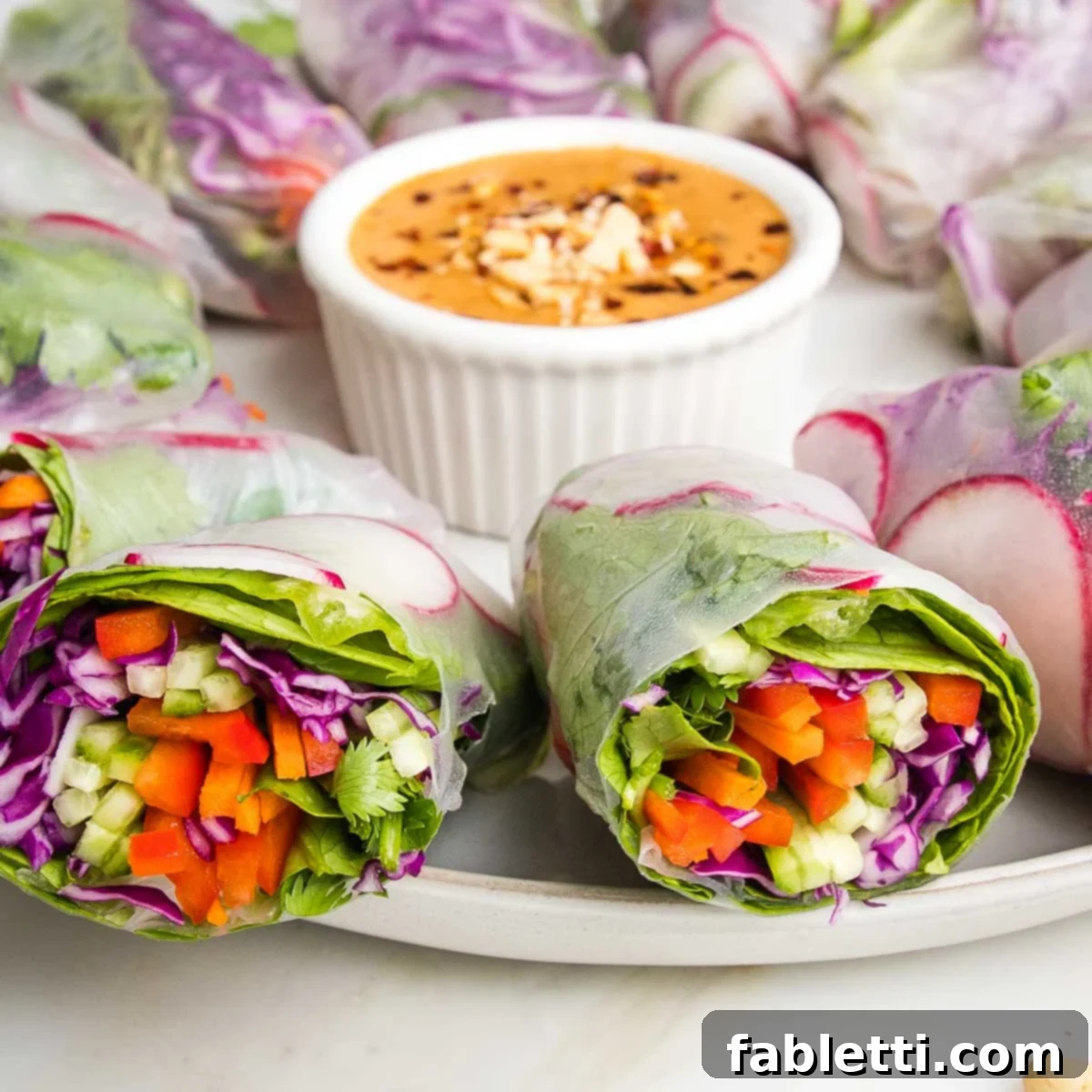The Ultimate Guide to Homemade Fresh Spring Rolls with Irresistible Peanut Dipping Sauce
Discover the delightful world of fresh spring rolls, a vibrant and healthy appetizer that’s surprisingly simple to make right in your own kitchen! Forget the notion that these delicate rolls are complex; with our step-by-step guide, you’ll learn how to perfectly prepare crisp, fresh vegetables, artfully arrange them in delicate rice paper wrappers, and craft an unbelievably delicious homemade peanut dipping sauce. These exquisite fresh rolls are naturally vegan and gluten-free, making them a perfect, crowd-pleasing starter for any occasion.
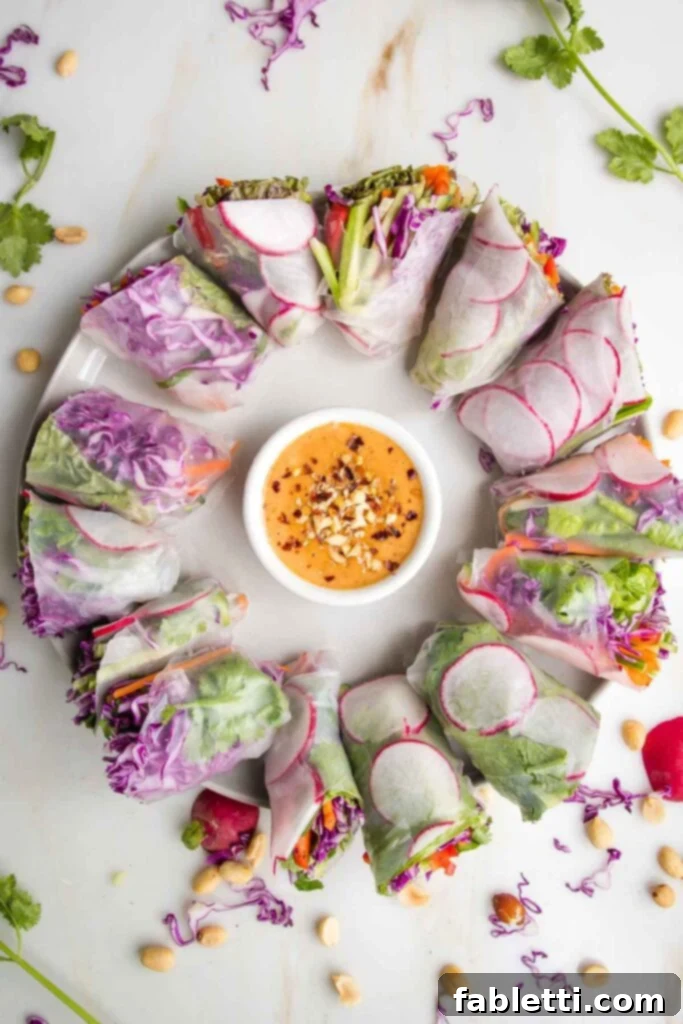
This recipe was originally published on August 20, 2016, and has been updated and expanded to bring you even more tips and insights for crafting the perfect fresh spring rolls.
Imagine a culinary creation that is both coolly refreshing, perfectly light, and incredibly satisfying. That’s exactly what you get with these effortless fresh spring rolls. Softened rice paper wrappers cradle an assortment of your favorite crunchy vegetables, creating a symphony of textures and flavors. And let’s talk about the homemade peanut dipping sauce – it’s truly a game-changer!
This sauce isn’t just good; it’s insanely delicious and dangerously addictive. A word of caution: you’ll want to drizzle this luxurious peanut butter sauce over everything, and don’t be surprised if your guests ask for a spoon to enjoy it straight from the bowl! Its rich, savory, and slightly sweet profile elevates every bite, making these fresh rolls an unforgettable experience.
While the peanut sauce is a star, these versatile rolls welcome other dips too. You can also pair them with a tangy mango dressing for a truly summery vibe, transforming them into “summer rolls.” Adjust the filling ingredients to suit the season – think seasonal produce for “spring” or “fall” rolls. Even a simple hoisin sauce straight from the bottle makes a legitimate and delightful dip during the winter months. Ultimately, call them “salad rolls” if you wish, as that’s an accurate description of these fresh, vibrant bundles of goodness – you do you!
Selecting the Finest Vegetables for Your Fresh Spring Rolls
When it comes to choosing the perfect fillings for your spring rolls, my guiding principle is simple: fresh, colorful, and crunchy! Any combination of these elements will yield spectacular results, offering both visual appeal and a delightful textural experience. The vibrant hues not only make your rolls more appetizing but also indicate a diverse array of nutrients.

- Purple Cabbage: I absolutely adore the striking pop of color that thinly shredded purple cabbage offers. Beyond its aesthetic appeal, it provides a satisfying crunch, is incredibly easy to work with, and is packed with beneficial nutrients.
- Red Bell Pepper: These sweet and vibrant peppers are not just for color; they are an excellent source of essential vitamins A and C, adding a subtly sweet and refreshing note.
- Carrot: Shredded or julienned carrots contribute another layer of beautiful color and a wealth of nutrition. They are an inexpensive, readily available, and versatile ingredient that adds natural sweetness.
- Fresh Cilantro: For those who appreciate fresh herbs, cilantro is a standout. Its bright, citrusy notes are quintessential to many Asian dishes. If cilantro isn’t to your taste (some find it soapy), feel free to substitute with other fresh herbs like refreshing mint, peppery Thai basil, or even flat-leaf parsley for a different, yet equally delicious, aromatic twist.
- Persian Cucumber: I prefer Persian cucumbers for their thinner, more tender skin, eliminating the need for peeling. However, any variety of cucumber will contribute a wonderful crispness and essential moisture to your fresh rolls, balancing the other ingredients.
- Radish: Radishes provide a delightful, peppery kick that’s not overtly spicy, adding an exciting zing to each bite. For an extra pretty presentation, arrange a row of thinly sliced radishes along the edge of your wrapper – it’s a small touch that makes a big visual impact!
- Lettuce Leaves: Who says leafy greens are only for salads? A crisp lettuce leaf, such as romaine or red leaf, serves as an excellent foundation within the roll, helping to hold all the delicious fillings in place. Beyond structure, lettuce adds crunch, a fresh green color, and is loaded with fat-soluble vitamins that are more easily absorbed when paired with the rich peanut sauce.
- OTHER VEGGIES & FILLINGS: The possibilities are truly endless, limited only by your imagination and what’s available! Feel free to incorporate any vegetable you love or have on hand. Consider adding slices of al dente baked sweet potatoes or delicate rice noodles to create more substantial spring rolls that can serve as a light dinner. Creamy avocado slices add a luxurious texture, while a smear of fresh pesto offers an unexpected yet delicious twist. Crunchy options like snow peas, crisp daikon radish, or delicate bean sprouts are fantastic choices. For an aromatic boost, thinly sliced fennel or fresh scallions work wonders. The best approach is to choose what’s in season and easily accessible to you, ensuring maximum freshness and flavor.
Mise en Place: The Secret to Effortless Spring Roll Assembly
The French culinary term “mise en place,” meaning “everything in its place,” is absolutely critical for a smooth and enjoyable spring roll making experience. Having all your ingredients prepped, chopped, and organized before you begin rolling is the single most important step. Once your filling ingredients are ready, the actual rolling process becomes quick, easy, and stress-free.
Use a small rimmed baking tray, a glass dish, or even multiple small bowls to neatly arrange your prepped vegetables. To keep everything fresh, especially if preparing in advance, cover the prepped ingredients with slightly damp paper towels and store them in the fridge until you’re ready to assemble. This prevents delicate veggies from drying out and maintains their crispness.
This “mise en place” philosophy is particularly crucial because there’s a delicate balance when working with rice paper wrappers. There’s a fine line between a wrapper that hasn’t soaked enough (remaining stiff and unpliable) and one that has soaked for too long or waited too long to be rolled (becoming an overly sticky, clingy, and frustrating mess). When it’s “go time,” you’ll want every ingredient at your fingertips, allowing you to focus solely on the art of rolling.
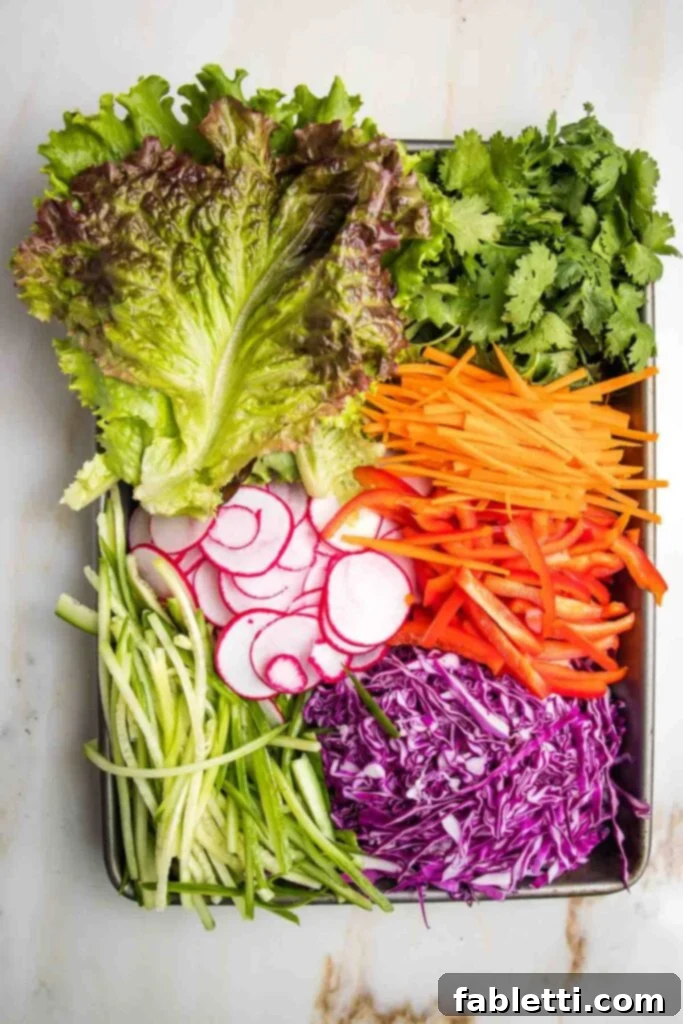
For uniform and easy-to-roll fillings, aim for a “julienne” cut, which describes long, thin strips. This cutting style makes it significantly easier to neatly pack and roll your spring rolls without bulky pieces tearing the delicate wrappers.
Achieving consistent julienned cuts is quick and easy with the right tools. I often use my mandoline slicer for efficiency. There are also many inexpensive handheld mandoline slicers that work wonderfully. Whichever tool you choose, always prioritize safety by wearing a cut-resistant glove to protect your hands. Of course, a sharp chef’s knife and a sturdy cutting board are perfectly capable tools for julienning, as is a dedicated julienne peeler.
Crafting the Perfect Peanut Dipping Sauce
The magic of these fresh spring rolls truly culminates in the dipping sauce. Transforming simple, wholesome pantry staples into the most incredible, creamy, and flavorful peanut butter sauce takes mere minutes. This simple homemade peanut dipping sauce is so easy to whisk together, you can have it ready in under 5 minutes, making it an ideal last-minute addition to your meal prep.
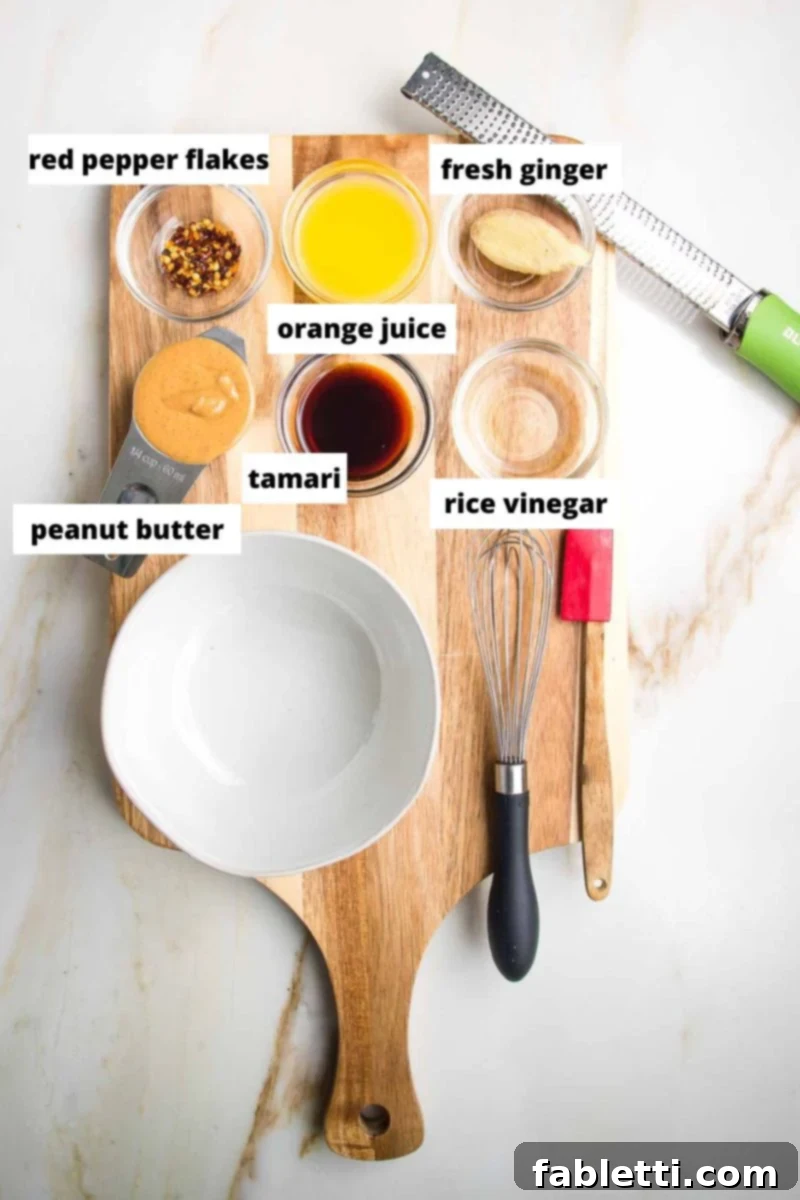
- Peanut Butter: The undeniable star of this rich and creamy sauce! For those with peanut allergies or who prefer an alternative, almond butter or sunbutter make excellent, equally delicious substitutes. Choose a natural, creamy variety for the best texture.
- Tamari: I typically opt for low-sodium, wheat-free tamari, which provides a deep, savory umami flavor without excess salt. Regular soy sauce or coconut aminos can also be used, depending on your dietary preferences and desired flavor profile.
- Rice Vinegar: This adds a gentle, subtle acidity that brightens the sauce, offering a mellower tang compared to harsher white vinegar. Be sure to select unseasoned rice vinegar to avoid unwanted added sugars.
- Orange Juice: The natural sugars and bright citrus notes from the orange juice provide the perfect amount of natural sweetness, balancing the richness of the peanut butter and the tang of the vinegar. If you prefer a sweeter sauce, a small splash of maple syrup or honey can be added to taste.
- Fresh Ginger: Grated fresh ginger is a must-have, infusing the sauce with a warm, zesty, and aromatic flavor that is both invigorating and known for its anti-inflammatory properties.
- Red Pepper Flakes: For a subtle warmth, start with just a pinch if you are sensitive to spice. If you enjoy a bit more kick and heat in your sauce, feel free to add a bit more to suit your preference.
Effortless Preparation: Making the Delicious Dipping Sauce
The true secret to these delectable fresh rolls often lies in their accompaniment – the sauce! Yes, the bulk of the flavor and indeed much of the fun comes from the dip. This is precisely why I recommend cutting your finished spring rolls in half; it allows for more opportunities to dip and enjoy that incredible flavor. Alternatively, place a spoon in the sauce bowl so everyone can generously drizzle it over their rolls, ensuring every bite is enveloped in its creamy goodness. This sauce is so incredibly tasty, you’ll undoubtedly want to make a double batch! Store any extra in the fridge; it makes a fantastic salad dressing, a superb dipping sauce for baked samosas or crispy baked tofu, or simply a wonderful reason to whip up another batch of veggie rolls.
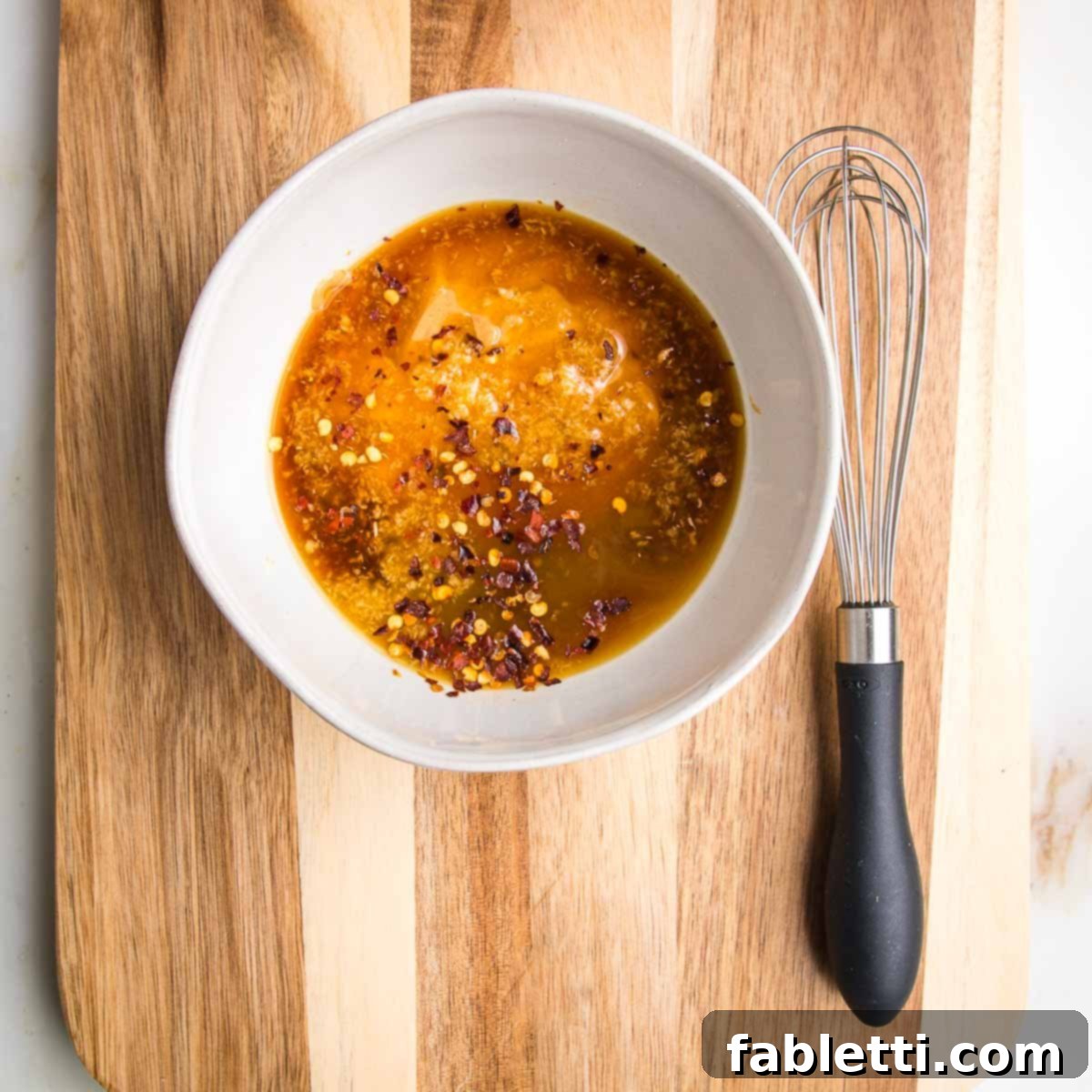
To begin, gather a small bowl, a whisk, and a microplane grater for the ginger. Add the creamy peanut butter, savory tamari, tangy rice vinegar, bright orange juice, and a pinch of crushed red pepper flakes to your small bowl. Use the microplane grater to finely grate the fresh ginger directly over the bowl, ensuring maximum flavor infusion.

With all ingredients combined, whisk everything together vigorously until the sauce is wonderfully smooth and creamy. If you find the sauce is a bit too thick for your liking, simply add 1-2 tablespoons of warm water, one at a time, and whisk again until it reaches your desired drizzly consistency. Taste and adjust seasonings as needed, perhaps adding a bit more spice or a touch more sweetness.
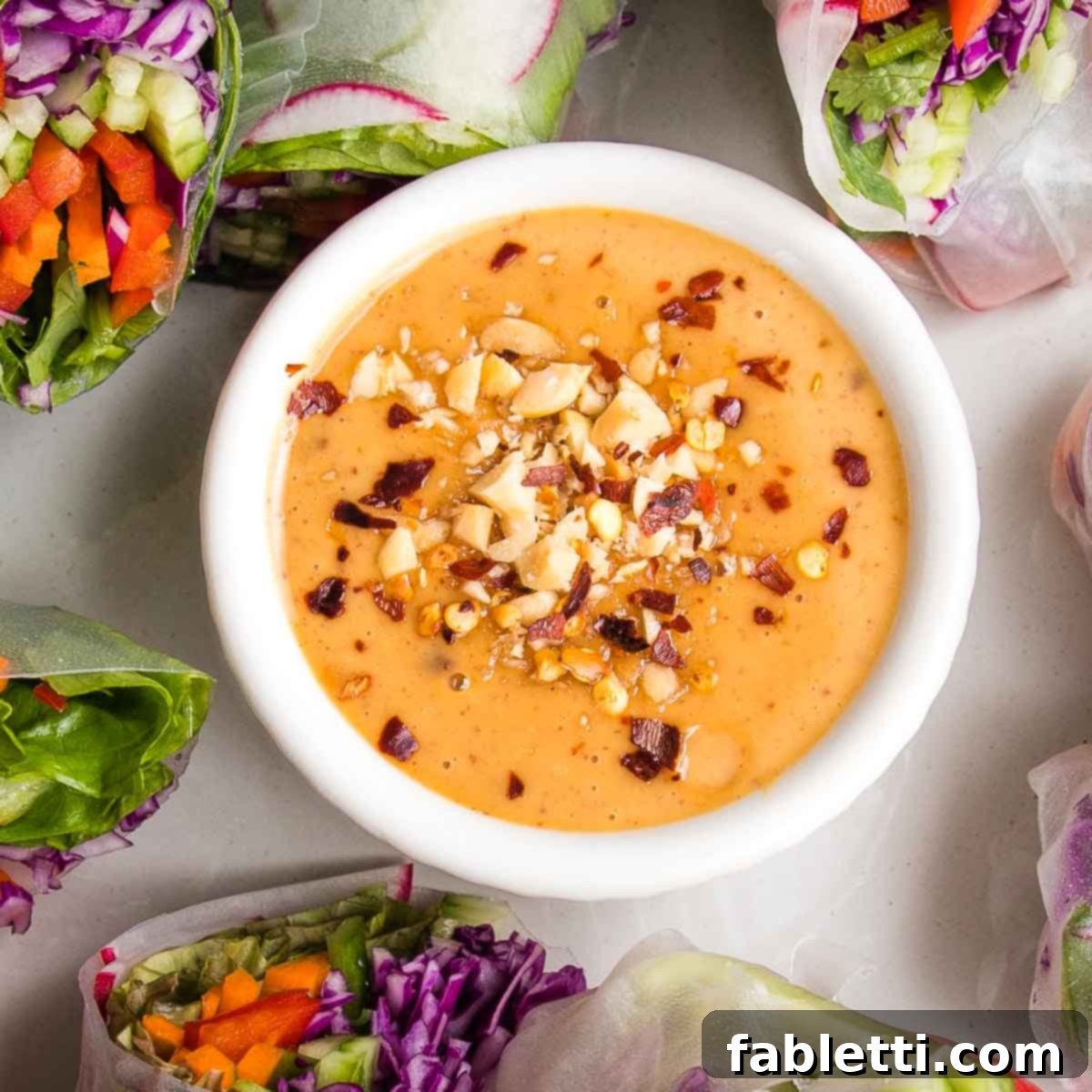
For an added touch of texture and visual appeal, sprinkle the finished sauce with crushed peanuts and a few extra red pepper flakes, if desired, just before serving. These garnishes not only look appealing but also enhance the overall flavor experience.
Mastering the Art of Rolling Fresh Spring Rolls
Making fresh spring rolls is an enjoyable and rewarding process, especially once you get the hang of it. Follow these steps for beautifully rolled, delicious results every time.

- Preparation is Key (Mise en Place): Start by meticulously prepping all your vegetables. Ensure everything is thoroughly washed, thinly sliced, or julienned into uniform strips. This pre-preparation, or mise en place, is crucial for a stress-free rolling experience.
- Prepare Your Dipping Sauce: While your veggies are ready, quickly whip up your chosen dipping sauce. Both the homemade peanut sauce and a vibrant mango dressing are fantastic options and take only minutes to prepare. The mango dressing is an excellent alternative for those with peanut allergies. You can prepare one or both to offer variety!
- Set Up Your Rolling Station: Find a large, clean, and flat surface for rolling. Have a shallow dish, such as a rimmed dinner plate or a pie plate, filled with warm water. This water will be used to soften the rice paper wrappers. Keep a clean kitchen towel nearby to dry your hands or workspace as needed, preventing stickiness.
- Soften the Rice Paper: Dip one rice paper sheet into the warm water. Submerge it completely for about 10-15 seconds, counting slowly. The goal is for the wrapper to become fully pliable and translucent, but not so excessively moist that it becomes overly sticky and difficult to handle. This timing is critical and often requires a few practice tries. Once softened, carefully remove it and lay it flat on your clean working surface.
- Practice Makes Perfect: Don’t get discouraged if your first few attempts aren’t perfectly smooth or tightly rolled. Mastering the technique and timing for softening the wrappers takes a little practice and patience. After a few rolls, you’ll develop your own rhythm and technique.

Remember that whatever you place on the bottom third of the wrapper will be visible on the outside of your finished roll, adding to its visual appeal. A neatly arranged row of round radish slices makes a beautiful and colorful choice. If you’re incorporating creamy avocado, consider placing a thin slice down first, or a stack of gorgeous purple cabbage for a vibrant effect.

Next, strategically place your primary filling ingredients in the center of the wrapper, slightly closer to the bottom third. Avoid overfilling, as this can make rolling difficult and lead to tears. Begin by piling on your chosen crunchy vegetables and fresh herbs, distributing them evenly to create a balanced roll.

To start the roll, gently lift the bottom edge of the rice paper wrapper and fold it up tightly over the filling. Ensure it’s snug against the vegetables to create a firm base for your roll. This initial fold is crucial for maintaining a tight, well-formed spring roll.
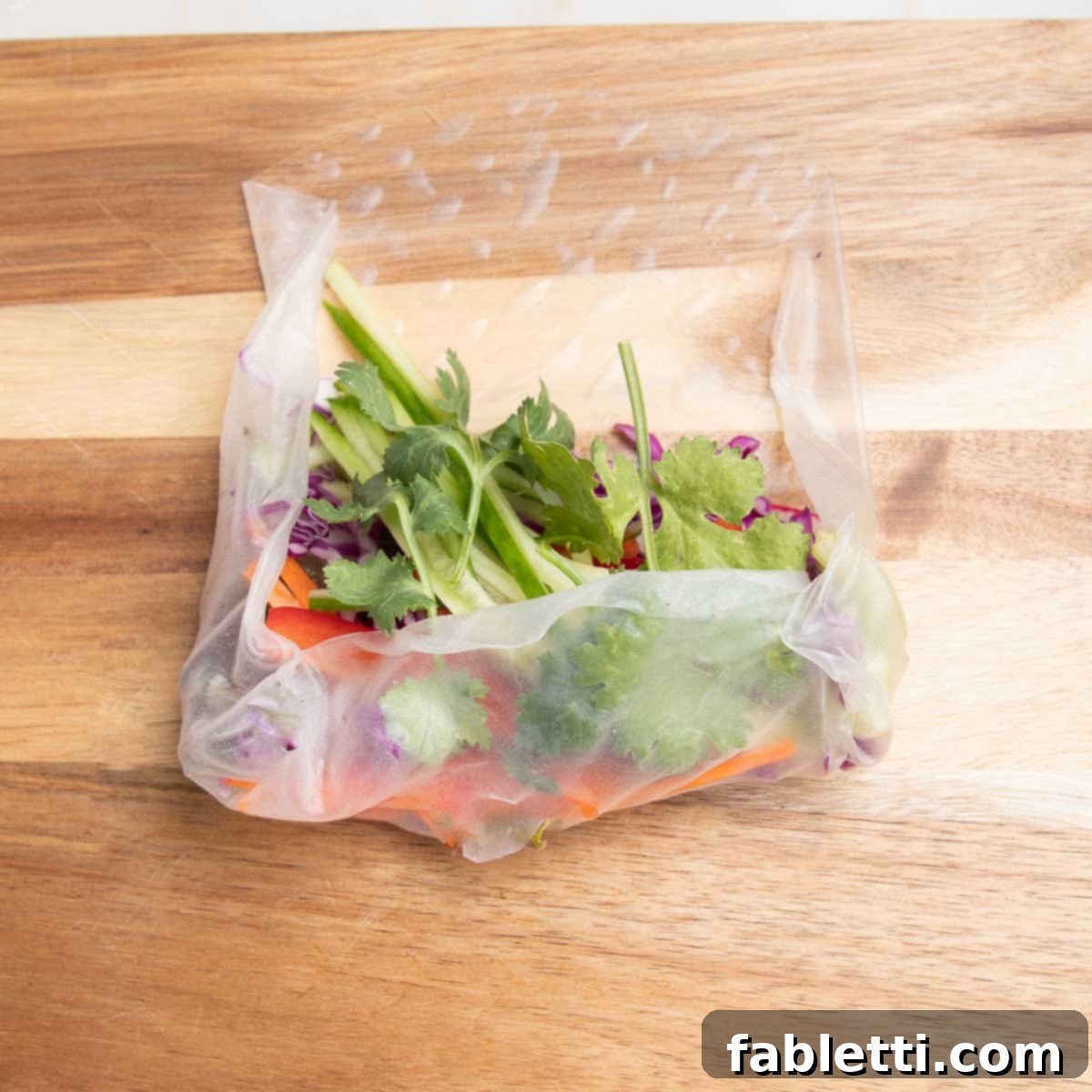
Next, fold in the two side edges of the wrapper, bringing them inwards towards the center. You’ll notice that the softened wrapper is already beginning to stick to itself, which helps in securing the filling. This creates a neat, burrito-like shape, encasing the vegetables tightly.

Now, continue to roll the wrapper slowly and firmly from the bottom upwards, maintaining a tight cylinder. The natural stickiness of the rice paper will ensure the edges seal themselves, creating a compact and secure spring roll. A consistent, gentle pressure is key to a smooth finish.
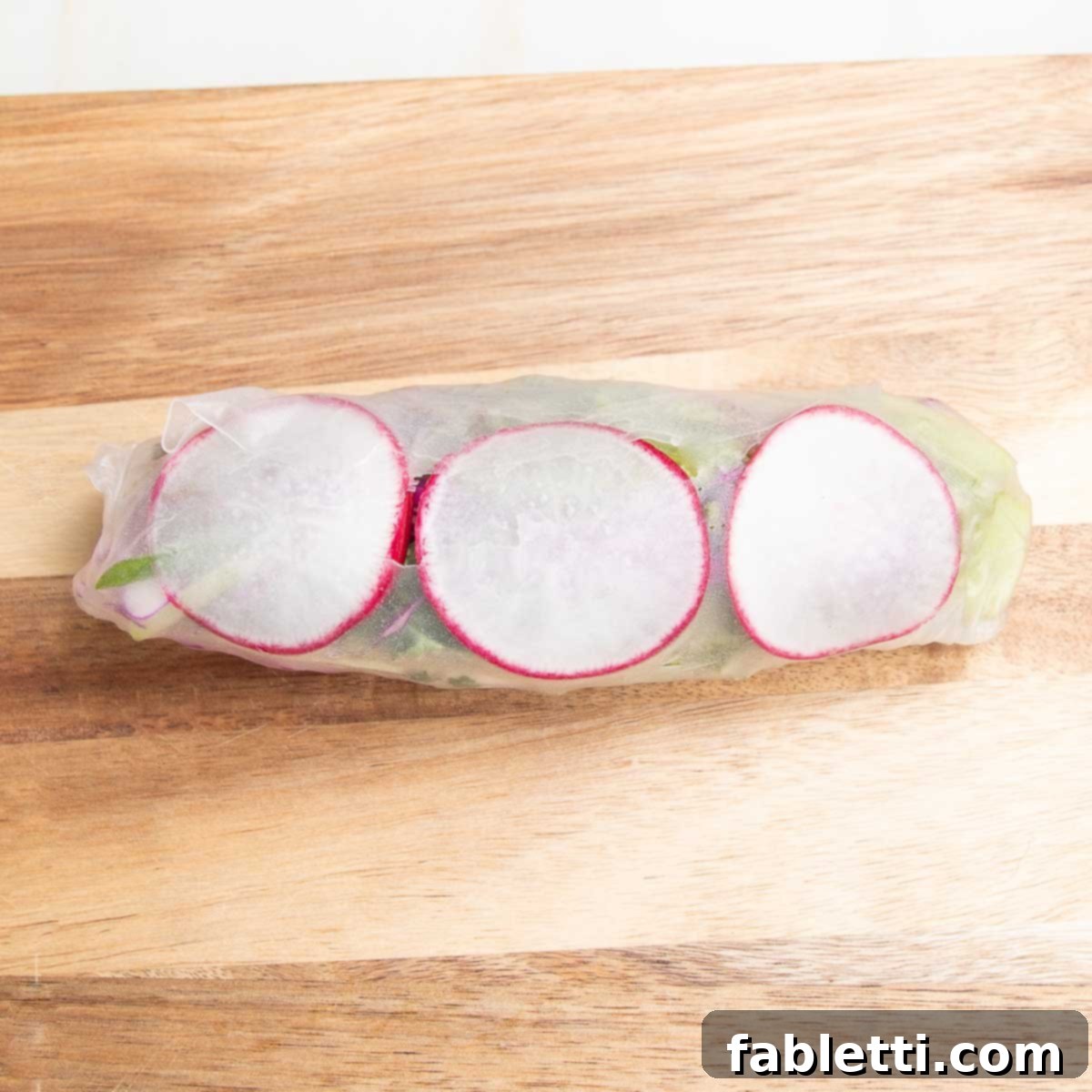
It’s perfectly fine if small holes or minor imperfections appear in your wrappers – this is common! If a wrapper gets a larger tear, don’t despair. Simply lay the damaged roll onto another softened rice paper sheet and re-roll. This double layer will securely keep the contents inside, and the finished roll will still taste absolutely delicious. No wasted efforts here!
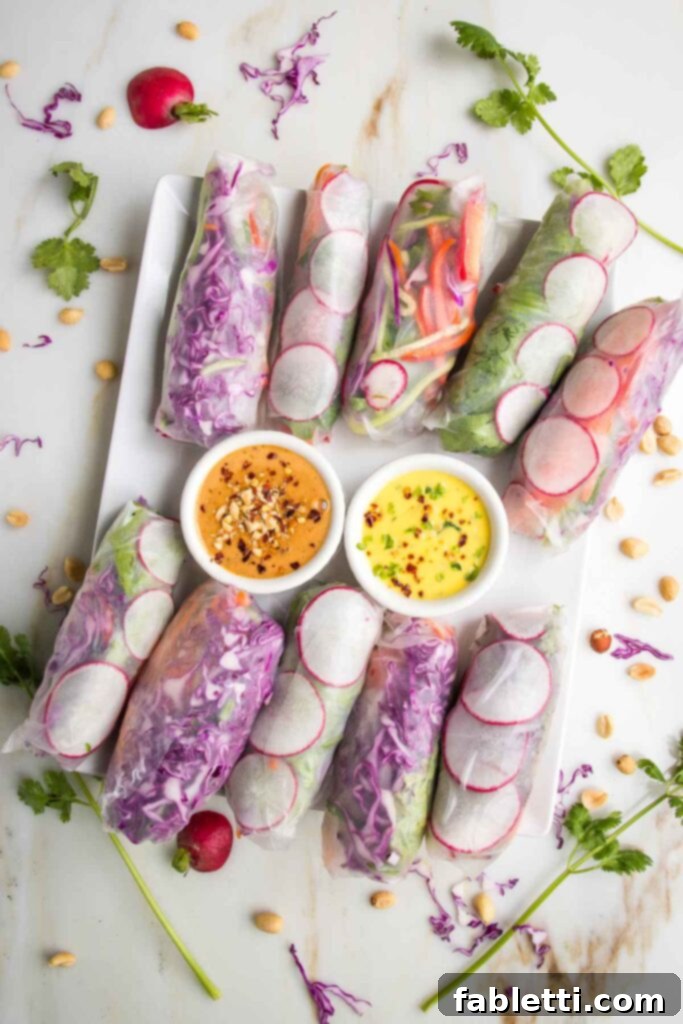
As you finish each roll, place it neatly on a serving platter. If you’ve made them in advance and plan to serve later, cover the rolls with a lightly damp paper towel and refrigerate them. This simple trick prevents them from drying out and keeps them perfectly fresh until you’re ready to enjoy. Arrange them appealingly around your dipping sauces for an inviting spread!
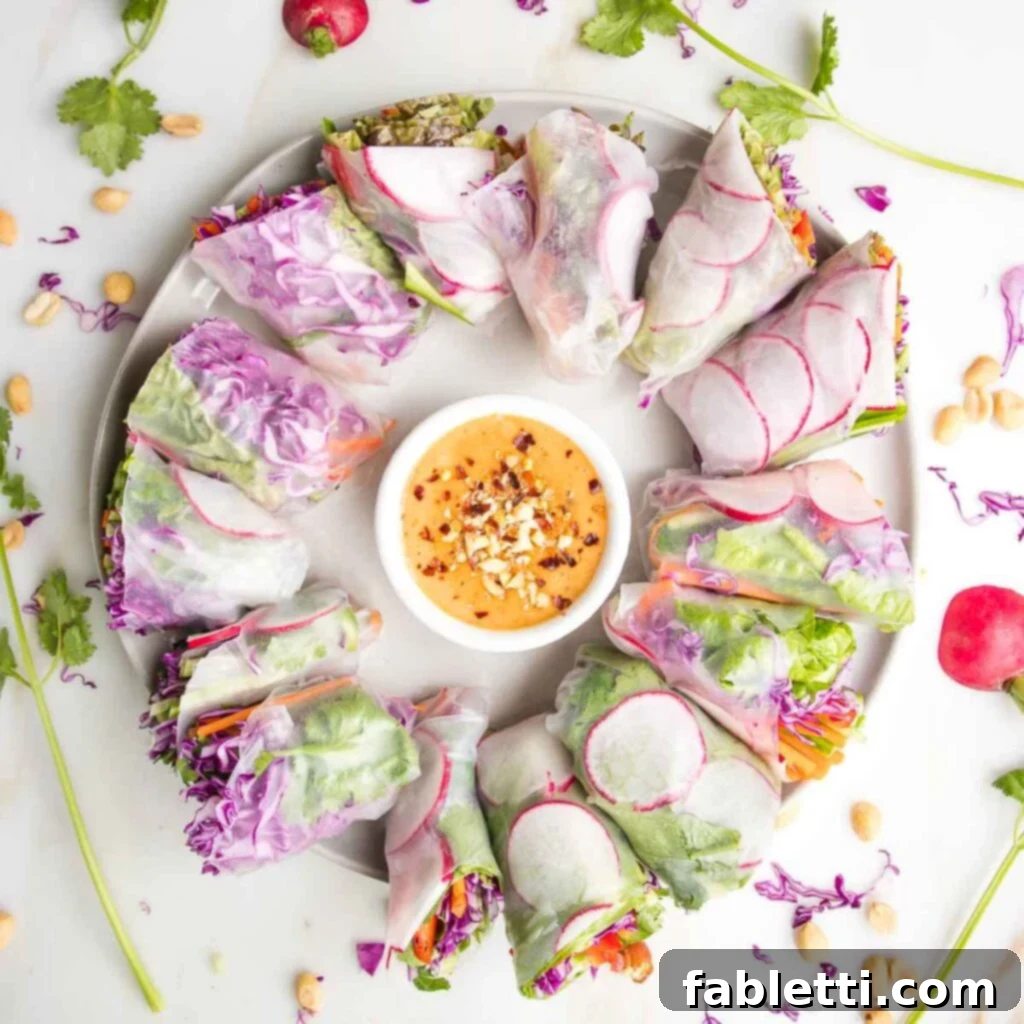
Unleash Your Creativity: What to Fill Fresh Spring Rolls With
The beauty of fresh spring rolls lies in their incredible adaptability. While we’ve discussed a core selection of vegetables, the best fillings are truly the ones you enjoy the most! Don’t be afraid to experiment and personalize your rolls to reflect your favorite flavors and what’s available seasonally.

- Our Featured Fillings: In this recipe, we’ve used a delightful combination of creamy avocado slices for richness, crisp green onions for a subtle bite, vibrant bell peppers for color and sweetness, shredded cabbage for crunch, and aromatic cilantro for fresh herb notes. This blend creates a balanced and incredibly flavorful roll.
- Embrace Imperfection & Efficiency: Don’t feel pressured for your veggie fillings to be perfectly julienned every single time. While uniform strips aid in rolling, a quick and easy prep is often more practical. Cut them into simple strips, use pre-shredded carrots from the grocery store, or coarsely rip lettuce leaves and fresh herbs. Whatever method gets you prepped and ready quickly and efficiently is absolutely the best approach. The goal is to make these rolls accessible and enjoyable to prepare, not overly complicated.
- Beyond Vegetables: Consider adding cooked and cooled rice vermicelli noodles for a more substantial roll. Cooked shrimp or thinly sliced cooked chicken or tofu can also be added for protein, transforming these appetizers into a light main course.
Demystifying Spring Roll Wrappers: What You Need to Know
Understanding spring roll wrappers is key to successful assembly. These delicate sheets are commonly known as rice paper wrappers and come in various sizes, typically 7 or 9 inches in diameter. When shopping, look for wrappers with a simple ingredient list – rice flour should always be the primary ingredient. They may also contain cassava flour or tapioca starch, which are perfectly acceptable and contribute to their pliability and translucency.
For the widest selection and best prices, Asian markets are an excellent resource, often offering a large variety suitable for all types of fresh Vietnamese spring rolls. You can also readily find them in the ethnic foods aisle of most local grocery stores.
The size of your wrapper impacts your serving style. Opt for larger rice paper sheets (like 9-inch) if you intend to make full-sized rolls that can serve as a main course. Once wrapped, these larger rolls can easily be cut in half on the bias to create elegant appetizers. Alternatively, if you prefer smaller, single-serving appetizers, choose the smaller 7-inch rice wrappers and serve them whole. Both options offer a healthy and appealing way to enjoy these fresh delights.
Debra’s Expert Tips for Perfect Spring Rolls
Achieving consistently beautiful and delicious fresh spring rolls comes with a bit of practice and some insider knowledge. Here are my top pro tips to guide you:
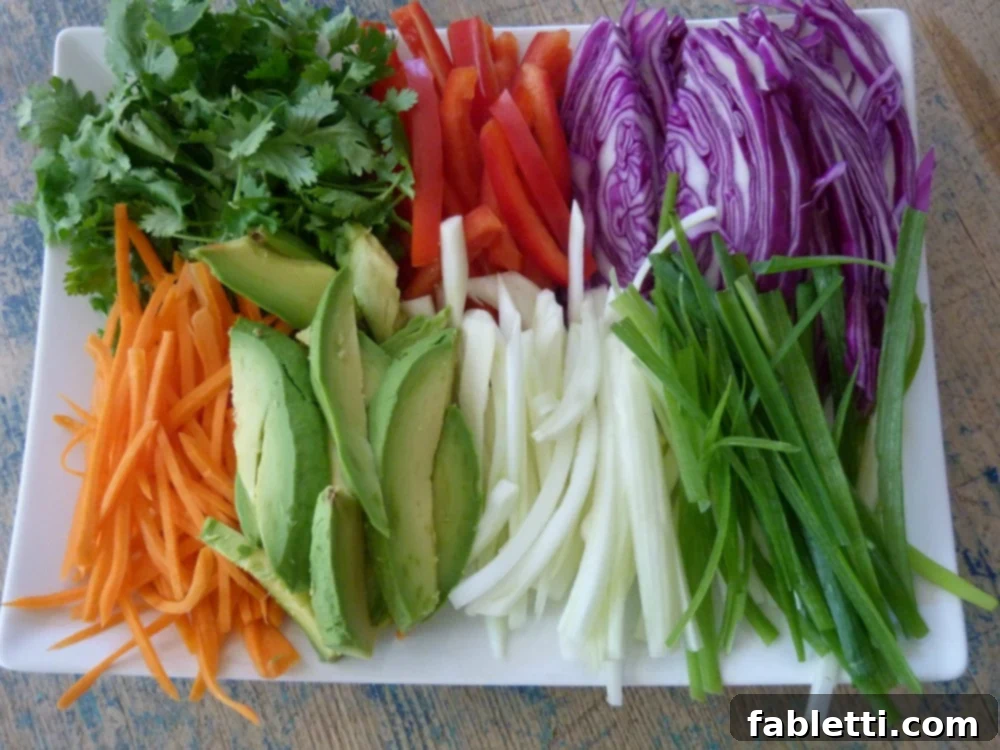
- Embrace Seasonal Ingredients: Always vary the filling ingredients you use based on what’s freshest and most abundant in season. This not only ensures the best flavor but also supports local producers and adds variety to your meals.
- Master Your Mise en Place: Whether you prefer to prep your ingredients a few hours in advance or just before you’re ready to roll, having everything washed, chopped, and organized is paramount. This foundational step is the ultimate way to take the stress out of making fresh rolls and ensures a smooth, enjoyable process.
- Keep Rolls Moist: To prevent your finished spring rolls from drying out before serving, cover them with a barely damp paper towel. Then, refrigerate until you’re ready to present them. This technique keeps the wrappers pliable and fresh.
- Choose the Right Wrapper Size: Use larger rice paper wrappers (e.g., 9-inch) if you plan to serve the rolls as a main course, or simply cut them in half for a more manageable appetizer portion. Smaller wrappers (e.g., 7-inch) are ideal for bite-sized, healthy appetizers.
- Revive Thickened Sauce: If your homemade peanut sauce thickens too much after being refrigerated, don’t worry! Simply whisk in 1-2 tablespoons of warm water until it returns to a perfectly pourable consistency.
- Patience with Wrappers: It’s completely normal if your first few attempts at rolling aren’t perfectly smooth and easy. The delicate timing for perfectly softening the rice paper sheets requires a little practice. Give yourself grace, and you’ll quickly figure out the ideal soak time.
- Utilize Leftover Veggies: Once you’re done rolling, gather all the leftover prepped vegetables. Dump them into an airtight container and store them in the fridge. This makes an excellent, ready-to-go base for a quick and nutritious salad the next day!

Did you know commenting and rating recipes is one of the best ways to support your favorite food bloggers? If you made this recipe, please consider a five-star rating below and leave a comment. Also, please share your photos on Instagram by tagging me @dkhealthcoach and using the hashtag #debraklein! Your feedback and shares are incredibly appreciated!
📖 Recipe Card: Veggie Spring Rolls with Peanut Sauce

Veggie Spring Rolls with Peanut Sauce
Author:
Debra Klein
This vegetable spring rolls recipe is easy to make with rice paper wrappers. Fresh veggies, with spring roll wrappers, dipped in homemade peanut sauce is just the fun vegan appetizer you’re going to make over and over.
Average Rating: 5 out of 5 stars from 47 votes
Print Recipe
Pin Recipe
15 mins
15 mins
12 rolls
56 kcal
Ingredients
For the Spring Rolls:
- 1 bunch red radish, thinly sliced into rounds
- 12 lettuce leaves
- ¼ head red cabbage, shredded
- 1 large carrot, cut into matchsticks
- 1 red bell pepper, thinly sliced
- 2 Persian cucumbers, thinly sliced lengthwise
- 1 bunch fresh cilantro
- 12 8-inch rice paper wrappers
Peanut Dipping Sauce
- ¼ cup creamy peanut butter
- 2 Tablespoons orange juice
- 1 Tablespoon unseasoned rice vinegar
- 1 Tablespoon low sodium tamari*
- 1 Tablespoon maple syrup
- 1 teaspoon grated fresh ginger
- ¼ teaspoon crushed red pepper
Instructions
- MAKE PEANUT DIPPING SAUCE: Add all sauce ingredients to a small bowl and whisk until smooth and creamy. If the dipping sauce is too thick, add 1-2 Tablespoons of warm water and whisk again to reach desired consistency. Taste for seasoning, adding more crushed red pepper or a splash of lime juice, to taste.
- PREPARE VEGGIES: Thinly slice radish into rounds. Shred or thinly slice cabbage. Cut carrots into matchsticks or julienne. Thinly slice red bell pepper. Julienne slice cucumbers lengthwise. Wash and thoroughly dry lettuce and cilantro leaves.
- Prepare a shallow dish (such as a pie plate or large dinner plate) with warm water. This will be used to soften the rice paper sheets for rolling. Have a kitchen towel handy to dry your hands or work surface if needed.
- Dip one piece of rice paper round into the warm water for about 10-15 seconds, or until it becomes soft and translucent, but not overly sticky. Carefully remove it and lay it flat on your clean, dry working surface to fill and roll.
- Place your desired filling into the lower half of the softened wrapper. For visual appeal, start with a neat row of round radishes. Then, layer a lettuce leaf, some shredded cabbage, carrots, bell peppers, cucumbers, and fresh cilantro. Remember not to overfill.
- To roll, first fold the bottom edge of the wrapper up and over the filling, tucking it in snugly. Then, fold in the two side edges towards the center. Continue to roll tightly like a burrito from the bottom upwards until you reach the end. The natural stickiness of the rice paper will seal the roll. Place each finished roll onto a serving plate, covering them with a barely damp towel to keep them moist and prevent drying out.
- You can cover the platter with plastic wrap and place it in the fridge until ready to serve, especially if preparing in advance.
- Just before serving, fill a small bowl with the prepared peanut dipping sauce and sprinkle with crushed peanuts and more red pepper flakes, if desired, for extra flavor and visual appeal.
Notes
FOR HOLES WHILE ROLLING: If one of your rolls tears significantly during assembly, it’s perfectly acceptable to double wrap it. Simply lay the torn roll onto another softened rice paper sheet and re-roll. It will still taste delicious!
OPTIONAL FILLING INGREDIENTS: Feel free to customize your spring rolls with other favorite fresh ingredients. Great options include green onions, additional avocado slices, cooked rice noodles or rice vermicelli, crunchy bean sprouts, fresh mint leaves, Thai basil, fresh parsley, arugula, cooked shrimp, or thinly sliced cooked chicken/tofu.
SPRING ROLL WRAPPERS: When purchasing, look for rice paper wrappers primarily made from rice flour and water. They may also contain cassava flour or tapioca flour, which are fine, but rice flour should always be the first ingredient listed. Rice paper sheets come in various sizes. For appetizers, buy the smaller ones or cut larger wrappers in half *after* you’ve rolled them.
PEANUT SAUCE VARIATIONS: For a more savory peanut sauce, consider adding 1 teaspoon of fresh lime juice and 2 teaspoons of toasted sesame oil. If you prefer a sweeter spring rolls sauce, try our vibrant mango dressing or enhance the peanut sauce with an additional 1 teaspoon of maple syrup.
TAMARI: Tamari is a gluten-free soy sauce. You can substitute it with regular soy sauce or coconut aminos, but always opt for the low-sodium variety for better control over the saltiness.
Nutrition
Serving:
2
rolls
Calories:
56
kcal
Carbohydrates:
7
g
Protein:
2
g
Fat:
3
g
Saturated Fat:
1
g
Polyunsaturated Fat:
2
g
Sodium:
80
mg
Fiber:
2
g
Sugar:
3
g
Note
The nutrition calculations were done using online tools. To obtain the most accurate representation of the nutritional information in any given recipe, you should calculate the nutritional information with the actual ingredients you used. You are ultimately responsible for ensuring that any nutritional information is accurate, complete, and useful.
Did you make this recipe?
Please leave a review below, then snap a picture and tag me @dkhealthcoach or use hashtag #dkhealtcoach on Instagram so I can see it!!
